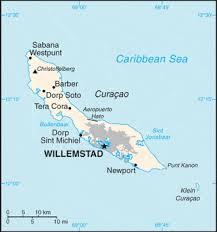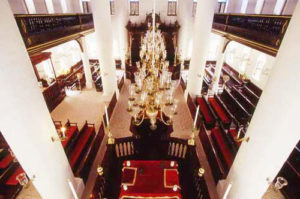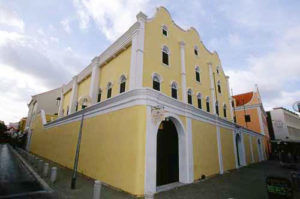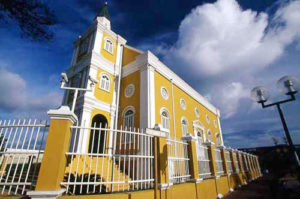 The history of the Jews in Curaçao can be traced back to the mid-17th century, when the first Jewish immigrants began to arrive. The first Jews in Curaçao were Sephardi Jewish immigrants from Netherlands, Portugal, and Spain. These immigrants founded Congregation Mikvé Israel-Emanuel, the oldest continuously used synagogue in the Americas.
The history of the Jews in Curaçao can be traced back to the mid-17th century, when the first Jewish immigrants began to arrive. The first Jews in Curaçao were Sephardi Jewish immigrants from Netherlands, Portugal, and Spain. These immigrants founded Congregation Mikvé Israel-Emanuel, the oldest continuously used synagogue in the Americas.
The first Jew to settle in Curaçao was a Dutch-Jewish interpreter named Samuel Cohen, who arrived on board a Dutch fleet in 1634. The first Sephardim began arriving in the 1650s and established the community of Mikve Israel. They were joined by a group of around seventy colonists arriving in 1659, under the patronage of Isaac da Costa, who brought with them a Torah scroll, as a gift from the Jewish congregation of Amsterdam. At the same time, the first cemetery Beth Haim was consecrated.
 By 1674, much of the population had migrated to Willemstad that a house was converted to serve as a congregational meeting place. The same year marked the arrival of the community’s first qualified rabbi, Josiau de David Pardo.
By 1674, much of the population had migrated to Willemstad that a house was converted to serve as a congregational meeting place. The same year marked the arrival of the community’s first qualified rabbi, Josiau de David Pardo.
In 1703, the Jewish community acquired a proper synagogue. Otrobanda became populated with less affluent Jews, who could not afford the higher rents in Willemstad. In 1732, the second synagogue of the Mikve Israel community was built, but this was too far from Otrobanda, so in 1746 another synagogue, Neve Shalom, was built there.
 By 1746, the Curaçao community was the largest Jewish population in the Americas, containing 270 families. It peaked two years later at 280 families, or around 1500 people. In 1864, about one-third of the Curaçaoan Jewish population broke from the orthodox tradition and built a new synagogue, Temple Emanuel, which adhered to the
By 1746, the Curaçao community was the largest Jewish population in the Americas, containing 270 families. It peaked two years later at 280 families, or around 1500 people. In 1864, about one-third of the Curaçaoan Jewish population broke from the orthodox tradition and built a new synagogue, Temple Emanuel, which adhered to the
principles of the Reform Jewish Movement. They also consecrated at cemetery at Berg Altena.
Not long after Temple Emanuel was founded, in 1864, Ashkenazi Jews, predominantly from Central Europe, began arriving in Curaçao in the 1920s and ‘30s and like their counterparts in the United States, took up as peddlers before becoming shop owners just as prominent as their Sephardic neighbors. The Ashkenazim established a social centre and sports club and dedicated their own congregational building called Shaarei Tsedek in Scharloo in 1959.
 After the riots of May 30, 1969 a number of Jews left Curaçao. Later, the economic crisis during the mid-1980s led to a further wave of emigration from Curaçao. In the 1980s, the congregation sold its building to move into a more suburban location, though its new building, round in shape with a stunning glass dome, was not completed and dedicated until 2006. As of 2013, the Jewish population is around 350. There are two synagogues in Willemstad, Mikve Israel which is Sephardi Reconstructionist, and an Orthodox Ashkenazi congregation. There is a community Hebrew school and kosher food is available.
After the riots of May 30, 1969 a number of Jews left Curaçao. Later, the economic crisis during the mid-1980s led to a further wave of emigration from Curaçao. In the 1980s, the congregation sold its building to move into a more suburban location, though its new building, round in shape with a stunning glass dome, was not completed and dedicated until 2006. As of 2013, the Jewish population is around 350. There are two synagogues in Willemstad, Mikve Israel which is Sephardi Reconstructionist, and an Orthodox Ashkenazi congregation. There is a community Hebrew school and kosher food is available.
Today tourists come to see the 285-year-old Mikve Israel-Emanuel Synagogue, and worship with descendants of the Jewish families who first moved to this tiny, remote island over 350 years ago from Holland to establish an agricultural colony called De Hoop (Hope). The sandy floor pays homage to those earliest Jewish settlers in Curaçao who had to muffle the sounds of their footsteps and prayers when meeting in secret during the Spanish Inquisition. Even today, the ground floor and balconies of the temple are covered with a two-inch layer of fine sand, to remind us of our past.